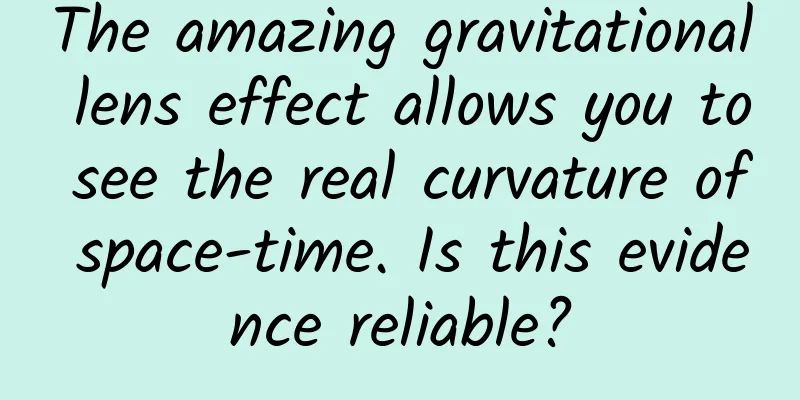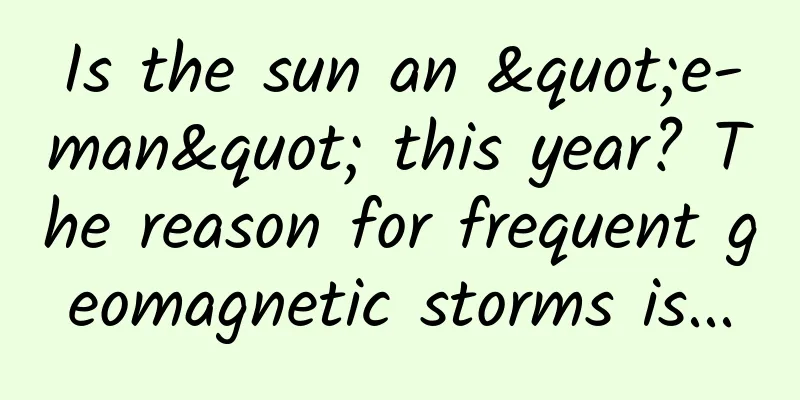The amazing gravitational lens effect allows you to see the real curvature of space-time. Is this evidence reliable?

|
Gravitational lensing is a conclusion and prediction derived from Einstein's theory of space-time curvature. Many people scoff at the theory of space-time curvature, believing that this invisible and intangible thing is just a random guess by scientists based on their imagination. The discovery of gravitational lensing gave these people a slap in the face, because the gravitational lensing effect can directly let people see the truth of the curvature of space-time, making this invisible curvature of space-time visible. What is the gravitational lens effect? The space-time curvature theory holds that mass will cause the surrounding space-time to bend. The greater the mass and the closer to the particle, the greater the curvature of the space-time. This curved space-time is invisible and intangible from a distance, but when an object approaches these massive celestial bodies, it will be changed by the curved space-time, tending to be pulled closer and move along its curvature. This phenomenon manifests itself in the form of gravity. This theory perfectly explains the origin of universal gravitation. The corresponding gravitational field theory, based on universal gravitation, corrects some errors and errors in Newton's classical mechanics, and makes calculations of celestial motion and aerospace more accurate. As early as 1911, Einstein proposed that due to the bending of surrounding space-time by massive celestial bodies, the light from distant stars would be slightly deflected when passing over the surface of the sun. In 1916, Einstein published the theory of general relativity, further systematically expounding the theory of space-time curvature. Einstein's theory was shocking and caused a strong response in the scientific community. In order to verify Einstein's theory of space-time curvature, British astronomer Eddington led an expedition team and traveled thousands of miles to the best solar eclipse observation point on Principe Island in Africa. On May 25, 1919, during a total solar eclipse, it was observed that the light from distant stars passed near the sun and deflected by 1.75". This verifies the prediction of Einstein's general theory of relativity: matter determines the shape of space-time, and mass distorts space-time, which manifests itself as a gravitational phenomenon, causing light to bend. In the universe, a massive celestial body in front can brighten the background galaxy in sight or distort its image. The principle is similar to the effect of an optical lens, so it is called the gravitational lens effect. The gravitational lens effect is generally composed of three conditions, namely the observer, the foreground object, and the observed background object. The observer is of course us humans on Earth, who observe celestial bodies in the universe through space telescopes and other facilities; the foreground object is the gravitational source object between the observed background object and the observer; the observed background object is the distant celestial body whose light passes through the gravitational lens and is observed by humans. By observing the light sources that pass through the gravitational lens, we can know the existence of this lens, thereby confirming the existence of the curvature of space-time. Gravitational lenses are being discovered, and more and more The picture shows the optical imaging of QSO 0975+561. The left picture below is the VLA imaging. It can be seen that A and B act as lenses G, and A and B are mirror-symmetric. The first to discover the gravitational lensing effect were a team of British and American astronomers: Dennis Walsh, Robert Carswell and Ray Weyman. They used the 2.1-meter optical telescope at Kitt Peak National Observatory in Arizona, USA, to observe two quasars QSO0957+561A and QSO0957+561B, which were very close to each other, with a viewing angle of only 6". The strange thing is that the spectra of these two quasars are very similar, the emission line redshift is 1.405, the absorption line redshift is 1.39, the radio flux density is also very close, and the apparent distance is so close. In the end, scientists believe that the two quasars are actually two virtual images of one entity, which is the image formed by the gravitational lens effect predicted by Einstein. The picture shows the spectra of the two images of the quasar QSO 0957+561A and B. The shapes are highly similar, so they are actually two mirror images of a quasar after gravitational lensing. After further observation and calculation, the QSO0957+561 quasar is 8.7 billion light-years away from us, while the celestial body YGKOW G1 (G1 for short) sandwiched between it and acting as a lens is 3.7 billion light-years away from us. This G1 is a huge galaxy that forms a huge gravitational lens. When the light of the QSO0957+561 quasar passes through the lens, it is magnified and forms two mirror images. In 1980, Weiman and his colleagues discovered another quasar, PG 1115+080, which looked like a triple image. However, one of the images was particularly bright, much brighter than the other two. It was later discovered that this was the result of the superposition of two images with a difference of 0.5". Therefore, the quasar image refracted by the gravitational lens was actually a quadruple image. This quadruple image gravitational lens effect is called the Einstein Cross. In theory, any celestial body will distort the surrounding space-time and form a gravitational lens, so it can be said that gravitational lenses are everywhere in the universe. However, this "lens" is only meaningful when the "lens" is large enough and there happens to be a magnified or multi-mirrored celestial body behind it, and the gravitational lens effect is more meaningful only when it is formed on distant celestial bodies. As more and more gravitational lenses are discovered, people have not only discovered multiple images of distant celestial bodies, but also Einstein rings. The so-called Einstein rings are caused by the gravitational lens effect, which distorts the light source passing through the lens into a ring shape. Around the edge of the gravitational lens, some are incomplete circles, while others are complete circles. In 1988, American astronomer Hewitt and others discovered the first incomplete Einstein ring, named MG1131 + 0456; in 1998, British astronomers used the Hubble Space Telescope to discover the first complete Einstein ring, named B1938 + 666. The beautiful ring in the picture below is not painted on, but a real photo of the gravitational lens effect. Now, the gravitational lens phenomenon is ubiquitous in the universe. According to the size of the gravitational source, people divide gravitational lenses into three levels: microlens, weak gravitational lens, and strong gravitational lens. The gravitational lens formed by celestial bodies such as the Sun is a typical microlens, which can only cause a small deflection of light from more distant celestial bodies when passing through; the magnifying and enhancing effect of weak gravitational lens is stronger than that of microlens, making the passing light source brighter; strong gravitational lens can significantly amplify the passing light source and change the star image, forming double images, multiple images, as well as semi-arcs and full arcs. Through these gravitational lenses, people can see more celestial objects that are farther away and brighter. Gravitational lensing allows people to see into the distant past Now, the scientific community has seen more and more distant celestial bodies through various huge and high-precision astronomical telescopes, such as the discovery of primitive stars more than 9 billion light years away and galaxies more than 13 billion light years away. However, these stars and galaxies are not seen directly by telescopes, but through the huge gravitational lens effect of the preceding celestial bodies, which magnifies the distant faint starlight many times. For example, in May 2016, astronomers saw light from a star 9 billion light years away, which was discovered by combining the Hubble telescope with a gravitational lens, making the light of this distant star much brighter. This star was named LS1 (Lens Star 1) and nicknamed "Icarus". Generally speaking, modern space telescopes can easily resolve single stars within 100 million light-years. Therefore, to find such stars, we must rely on the gravitational lens effect and find a forward gravitational source right in the middle of the star. The gravitational lens formed by this gravitational source can generally be easily magnified 50 times, so that single stars within 100 million light-years can be distinguished. The gravitational lens sandwiched between the stars of LS1 magnified the star 2,000 times, and the powerful function of the Hubble telescope, which increases the resolution by 600 million times that of the human eye, allowed astronomers to see this star. According to the relationship between human eye observation and the speed of light, the farther away something is, the older it is. Gravitational lensing allows people to see celestial bodies more than 13 billion light years away, so it can be considered that these celestial bodies are the state of the early Big Bang, that is, the infant state of the universe, which plays a significant role in studying the evolution of the universe. Two new dark clouds in modern physics At the beginning of the 20th century, the scientific community believed that the main body of the physics building of mankind had been completed, and only some decoration work remained. However, two dark clouds appeared in front of people: one was the wave dynamics of light, and the results of the Michelson-Morley experiment contradicted the ether drift theory; the other mainly referred to the fact that the law of equipartition of energy in thermodynamics produced results that were inconsistent with the experimental results in the theoretical explanation of the specific heat of gases and the thermal radiation energy spectrum, among which the "ultraviolet catastrophe" that appeared in the blackbody radiation theory was the most prominent. Einstein and Planck These two dark clouds brought crisis to the theory based on Newton's classical mechanics and Maxwell's unified electromagnetic theory. Would these buildings collapse or be demolished and rebuilt? For a time, the physics community was shrouded in confusion and panic. The birth of Einstein's theory of relativity and Planck's quantum mechanics cleared the clouds for physics. As a result, relativity and quantum mechanics became the two most important cornerstones of modern physics, and physics moved from classical to modern. Now, two bigger dark clouds have appeared in physics. They are invisible and intangible, but they seem to be everywhere. These are dark matter and dark energy. When studying the laws of motion of celestial bodies in the universe, people have found that there are always discrepancies with the theory, and the discrepancies are quite large. For example, in 1933, astrophysicist Zwicky used spectral redshift to measure the motion speeds of galaxies in the Coma Cluster and found that the velocity dispersion of these galaxies was extremely high. The gravitational force of the visible mass of the galaxies could not bind these galaxies at all, and the galaxy cluster had already fallen apart. Therefore, he pointed out that there must be other invisible matter in this galaxy cluster. After calculation, this matter is at least 100 times more than visible matter. Later, scientists discovered that this phenomenon is universal in the universe, and thus named this invisible matter "dark matter". This leads to another contradiction: if dark matter exists in our universe, the gravitational force between them is very huge, and the entire universe should be shrinking. However, research has found that the universe is still expanding at an accelerated rate. Where does this expansion force come from? This force is also invisible and intangible, so scientists call this energy "dark energy." How big is this dark energy? After some complex calculations of the expansion of the universe and the gravitational effects of galaxies, people have concluded that dark energy is several times more than dark matter. Now the general understanding in the scientific community is that in our universe, observable matter such as stars, galaxies, and interstellar matter only accounts for 4.9% of the total universe, while dark matter accounts for 26.8% and dark energy accounts for 68.3%. Therefore, the future and fate of our universe seem to be determined not by visible matter, but by the game between dark matter and dark energy. If we do not clarify these two "dark clouds" hanging over astrophysics, it will be difficult for humans to find the deeper truth of the universe. But dark matter and dark energy cannot be observed, so what are they? What is their distribution in space? This is a question that the scientific community has been trying to figure out for decades. Thankfully, gravitational lensing has made dark matter visible Dark matter is not charged, so it will not interact with photons. Humans rely entirely on light (visible light, radio waves and rays are all different wavelengths of light) to observe matter, so dark matter is transparent to humans. Although people can calculate the mass of dark matter in a galaxy or galaxy cluster through gravitational effects, what if we know the distribution of this dark matter in space? The gravitational lens effect gives people a glimmer of hope. The celestial bodies that produce the gravitational lens effect may be giant black holes, galaxies, galaxy clusters, etc., or they may be simple dark matter clusters. Even in visible galaxy clusters and other celestial bodies, dark matter occupies a major position. Although dark matter does not emit any radiation and cannot be directly observed, since it plays an important or even major role in the gravitational lens effect, scientists can use the gravitational lens effect to analyze its distribution in space. Therefore, the gravitational lens effect becomes a probe for discovering dark matter in the universe. In January 2007, European and American scientists published for the first time a three-dimensional map of the distribution of dark matter in local space, which was obtained by the gravitational lens effect. This map is the result of the wisdom of 70 astronomers, who worked together to analyze 575 photos taken by the Hubble telescope over 1,000 hours, found 500,000 galaxies distorted by gravitational lenses, and produced this three-dimensional map of dark matter. This 3D map of dark matter distribution was selected by academicians of the two Chinese academies as one of the world's top ten scientific and technological achievements in 2007. The map covers a 2.2°^2 area of the Sextans constellation, equivalent to the area of 9 full moons, and the distances are divided into three levels: 3 billion light years, 5 billion light years, and 6.5 billion light years. On August 21, 2006, American scientists released a set of composite images taken by the Hubble and Chandra space telescopes in 2004. This is a composite image of the "Bullet Cluster" located in 1E0657-56 Carina, 3.4 billion light-years away from us, formed by the collision and merger of two large galaxy clusters. The photo shows the effects of three telescopes with different wavelengths, including red hot gas, white and yellow galaxies, and a blue area, which is the dark matter in the galaxy cluster. The distribution of these dark matter is analyzed and depicted based on the gravitational lens effect formed by galaxy clusters. The image clearly shows the collision process of galaxy clusters, the separation process of dark matter and ordinary matter, and the spatial distribution state. On May 15, 2007, the Hubble Telescope released an image of a dark matter ring in the galaxy cluster CL0024+17, with a diameter of 2.6 million light years. The photo shows many blue arcs, which are some more distant galaxies distorted by gravitational lenses. This photo was taken by the Hubble Telescope in November 2004 using 6 different wavelength filters and exposed for 14 hours. On August 16, 2007 and August 27, 2008, Hubble and Chandra telescopes released two similar photos: Abell 520 galaxy cluster in Orion, 2.4 billion light-years away; MACS J0025.4-1222 galaxy cluster in Cetus, 5.9 billion light-years away. These are direct evidence of the existence of dark matter in the universe. At present, the scientific community has many methods to explore dark matter and dark energy, but gravitational lensing has always played an irreplaceable role in them. It also plays an important role in scientific practices such as measuring the Hubble constant and determining the age of the universe. These are all follow-up results of Einstein's theory of space-time curvature and are ironclad evidence of space-time curvature. After reading this, do you still think that space-time curvature does not exist? Welcome to discuss, thank you for reading. The copyright of Space-Time Communication is original. Infringement and plagiarism are unethical behavior. Please understand and cooperate. |
Recommend
If you could do it all over again, would you still choose me as your mentor? — The growth of a "Shamatte" boy
Produced by: Science Popularization China Author:...
In the New Year's greetings, those great weapons of the great powers that can "go to the sky, the sea and the land"
President Xi Jinping has delivered New Year's...
Decoding the consumer psychology used by Pinduoduo in its promotions
You know exactly what to do to succeed, and then ...
Maria Goeppert-Meyer, the "Onion Madonna" who deciphered the structure of the atomic nucleus
February 20, 2022 marks the 50th anniversary of M...
Channel Operation丨If you want to be a promotion expert, you need to combine surprising tactics
There is a saying that "channels are king&qu...
How to attract users with a budget of 0? Teach you 5 unique skills and talk about some traps!
Recently, some pure product personnel who work be...
7 months to get 10 million fans on Douyin_Free online viewing
From the beginning to profitability, we will brea...
The guy inserted a catheter into his own heart and won a Nobel Prize!
This article was first published by Hunzhi (WeCha...
Caisen 2021 Options Practical Basic Course 1 Video
Caisen 2021 Options Practical Basic Course 1 Vide...
Samsung products have been in trouble in China because of its arrogance and disregard for Chinese users.
As one of the world's top technology companie...
How do you monetize your product? Here are 3 channels to help you sort out
As dividends disappear and capital returns to rat...
How to plan a complete online event? Here is a complete plan
Why is it that with the same budget, the final re...
The "Top Ten Product Traps" Often Ignored When Planning Promotion
Introduction丨If you don’t understand product plan...
Bird Lover Week is here! Why do these beautiful birds love this place?
Birds are an important part of the ecosystem. Eff...
Zhu Shiba's "Xuelang Plan: From Settlement to Selling Courses" explains the whole process of Xuelang selling courses
Zhu Shiba's "Xuelang Plan: From Settleme...









